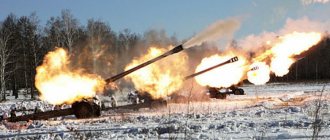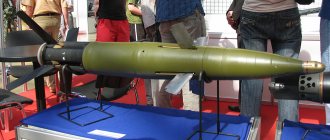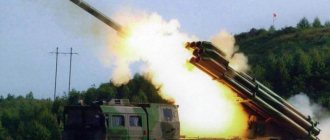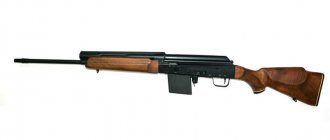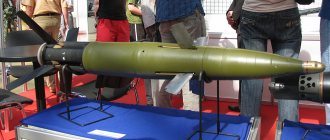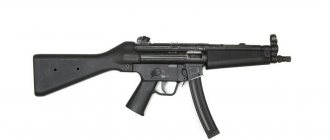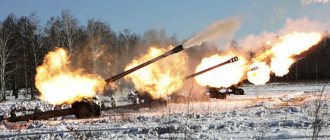Russian and Ukrainian patrol ships of Project 11351 are equipped with 30-mm AK-630 automatic close-range air defense artillery mounts. The creation of the AK-630 installation was due to the improvement of anti-ship missiles. To intercept missiles flying at high speed and at low altitude, it was necessary to sharply increase the density of fire from naval anti-aircraft artillery.
Characteristics of the automatic shipborne installation AK-630M
A country:USSR/RussiaType:Automatic ship installationDate of issue:1980Calculation:1 personCaliber:30mmLength:barrel length 54 caliberWidth:No informationWeight:3.8 tons (installation weight), 9.11 tons (installation with control system and ammunition)Rate of fire:up to 5000 rounds/min (for the entire installation)Firing distance:Horizontal 4000 m, vertical 4000 mInitial projectile speed:1030 m/sAmmunition:2000 shells per barrel
17th century naval artillery
In the 16th and 17th centuries, artillery, including naval artillery, received further development. The number of guns on ships increased due to their placement on several decks. Ships during this period were created with the expectation of artillery combat.
By the beginning of the 17th century, the type and caliber of ship guns had already been determined, and methods of firing them had been developed, taking into account maritime specifics. A new science has emerged - ballistics.
It should be noted that ship cannons of the 17th century had barrels of only 8-12 calibers. Such a short barrel was caused by the need to completely retract the gun into the ship for reloading, as well as by the desire to lighten the gun.
In the 17th century, along with the improvement of ship guns, ammunition for them also developed. Incendiary and explosive shells appeared in the fleets, causing serious damage to the enemy ship and its crew. Russian sailors were the first to use explosive shells in 1696, during the storming of Azov.
History of creation and internal structure of the AK-630M installation
AK-630M is a six-barrel automatic shipborne self-defense unit, 30 mm caliber . The main purpose of the AK-630M is to combat air and light surface targets. Possessing an enormous rate of fire, the installation is capable of literally creating a cloud of projectiles around itself aimed at the target. Its standard firing mode is up to 5 bursts of 20-25 shots at the maximum range and bursts of 400 shots at closer distances with 3-5 second intervals, thus firing per minute, thus amounting to up to 5000 shots.
The AK-630M complex was adopted for service by Order of the Navy Civil Code No. 0189 of August 26, 1980. Serial production was carried out at plant No. 535 in Tula.
The AK-630M installation has a belt magazine for 2000 rounds of ammunition in a belt, in a barbette; an additional belt for 1000 rounds is placed under the installation. Its code “AK” means (ship artillery), the numbers “6” indicate the number of barrels, “30” indicates the caliber. The block of rotating barrels is an AO-18 assault rifle with general automatics, which makes it possible to combine reloading operations as much as possible in time and obtain a high rate of fire. The barrels are cooled by passing antifreeze between the casing and the barrels. A fiberglass fairing is located above the rotating part of the installation, protecting its mechanisms from sea water and precipitation.
There are two types of ammunition for the AK-630M installation: OFZ - high-explosive fragmentation incendiary projectile OF-84 weighing 390 g and fragmentation tracer projectile OR-84 weighing 390 g.
Although the ballistic firing range of the installation reaches 8.1 km, the shells self-destruct at a distance of 5 km. The MP-123 Vympel-A fire control system provides an inclined firing range of 4000 meters.
Interesting fact: A lightweight version of the AO-18, under the name GSh-6-30A, was used as a standard weapon on some Russian fighter-bombers.
Automatic ship installation AK-630M
The Birth of Naval Artillery
For a long time (until the 16th century), ships had only weapons for close combat - a ram, mechanisms for damaging the ship's hull, masts and oars. Boarding was the most common method of resolving conflicts at sea.
The ground forces were more creative. On land at this time all kinds of throwing mechanisms were already in use. Later, similar weapons began to be used in naval battles.
The invention and distribution of gunpowder (smoky) radically changed the armament of the army and navy. Gunpowder became known in Europe and Rus' in the 14th century.
However, the use of firearms at sea did not delight the sailors. The gunpowder often became damp, and the gun misfired, which in battle conditions was fraught with serious consequences for the ship.
The 16th century marked the beginning of a technical revolution in conditions of rapid growth of productive forces in Europe. This could not but affect the weapons. The design of the guns changed, and the first sighting devices appeared. The gun barrel became movable. The quality of gunpowder has improved. Ship cannons began to play a prominent role in naval battles.
Application of AK-630M in the fleet
The automatic six-barreled AK-630M installation was at different times used by the following USSR/Russian ships:
- Large anti-submarine ships of Project 1134-A
- Large anti-submarine ships of Project 1134-B
- TARK "Admiral Lazarev"
- TAKR "Admiral of the Fleet of the Soviet Union Kuznetsov"
- Project 1143 TAKR "Krechet"
- Project 956 "Sarych" EM
- Project 1164 cruisers
- Large reconnaissance ship SSV-33 "Ural"
- Project 1135 patrol ships
- Project 11356 patrol ships
- Small rocket ships of project 1239
- Small anti-submarine ships of project 1124
- Small rocket ships of project 1234
- Project 1241 missile boats
- Project 10410 patrol boats
- Small landing hovercraft project 12322
- Small artillery ships of project 1208 and 12081
Operators[edit]
| This section requires additional links for verification . |
Map of AK-630 operators in blue with former operators in red
Current operators[edit]
- Algerian National Navy on the Steregushchiy-class corvette
- Bulgaria
- Cameroon
- People's Republic of China [18]
- Croatia
- Cuba
- Egypt
- India [1] [18]
- Indonesia
- Greece
- Kenya
- Myanmar
- North Korea
- Pakistan
- Poland [1]
- Romania
- Russia [1] [18]
- Slovenia [18]
- Ukraine [18]
- Vietnam
- Yemen
Former operators[edit]
- East Germany [1]
- Germany
- Soviet Union [1] [18]
Modern requirements for naval artillery
According to the head of the 19th test site, Alexander Tozik, today's requirements for ship guns partially remain the same - these are the reliability and accuracy of the shot.
In addition, modern naval guns must be light enough to be installed on light warships. It is also necessary to make the weapon inconspicuous to enemy radar. A new generation of ammunition is expected with higher lethality and increased firing range.
18th century ship armament
The 18th century ship's cannon already had a flintlock. However, her weight has hardly changed since the last century and was 12, 24 and 48 pounds. Of course, there were guns of other calibers, but they were not widely used.
The guns were located throughout the ship: on the bow, stern, upper and lower decks. At the same time, the heaviest guns were located on the lower deck.
It is worth noting that large-caliber naval guns were mounted on a carriage with wheels. Special grooves were made in the deck for these wheels. After the shot, the gun rolled back with recoil energy and was again ready to load. The process of loading ship guns was quite a complex and risky task.
The firing efficiency of such guns was within 300 m, although the shells reached up to 1500 m. The fact is that with distance the projectile lost kinetic energy. If in the 17th century a frigate was destroyed by 24-pound shells, then in the 18th century the battleship was not afraid of 48-pound shells. To solve this problem, in England, ships began to be armed with 60-108-pound cannons with a caliber of up to 280 mm.
The new role of naval artillery in modern conditions
The 20th century made its own adjustments to the previously existing priorities in naval artillery. The development of naval aviation was the reason for this. Air raids posed a greater threat to the ship than enemy naval guns.
World War II showed that air defense had become a vital system in naval warfare. The era of a new type of weapon - guided missiles - was beginning. Designers switched to rocket systems. At the same time, the development and production of main caliber guns was stopped.
However, the new weapons were not able to completely replace artillery, including naval artillery. Guns whose caliber did not exceed 152 mm (calibers 76, 100, 114, 127 and 130 mm) still remained in the navies of the USSR (Russia), USA, Great Britain, France and Italy. True, now naval artillery was assigned more of a auxiliary role than a shock one. Ship guns began to be used to support landing forces and protect against enemy aircraft. Naval anti-aircraft artillery came to the fore. As you know, its most important indicator is the rate of fire. For this reason, the rapid-firing naval gun became the object of increased attention from military personnel and designers.
To increase the frequency of shots, automatic artillery systems began to be developed. At the same time, the emphasis was placed on their versatility, that is, they should equally successfully protect the ship from enemy aircraft and fleets, as well as cause damage to coastal fortifications. The latter was caused by the changed tactics of the navy. Sea battles between fleets are almost a thing of the past. Now ships have become increasingly used for operations near the coastline as a means of destroying enemy ground targets. This concept is reflected in modern developments of ship weapons.
Interesting Facts
In 1983, a project for an unprecedented naval gun appeared in the USSR, outwardly reminiscent of the chimney of a 19th-20th century steamship with a diameter of 406 mm, but with the only difference that it could launch... a guided anti-aircraft or conventional projectile, a cruise missile or a depth charge with nuclear filling . The rate of fire of such a universal weapon depended on the type of shot. For example, for guided missiles this is 10 rounds per minute, and for a conventional projectile - 15-20.
It is interesting that such a “monster” could easily be installed even on small ships (2-3 thousand tons with displacement). However, the Navy command did not know of such a caliber, so the project was not destined to be realized.
Why weren’t the guns on ships written off by history as scrap?
At first glance, missile weapons of the 20th century were supposed to replace classical artillery, including in the navy, but this did not happen. Missiles could not completely replace naval guns. The reason lies in the fact that an artillery shell is not afraid of any types of passive and active interference. It is less dependent on weather conditions than guided missiles. A salvo of naval guns inevitably reached its target, unlike its modern counterparts - cruise missiles.
It is also important that naval cannons have a higher rate of fire and a larger ammunition load than missile launchers. It should be noted that the cost of ship guns is much lower than missile weapons.
Therefore, today, taking these features into account, special attention is paid to the development of naval artillery installations. The work is carried out in the strictest secrecy.
And yet today, an artillery installation on a ship, with all its advantages, plays more of a supporting role in a naval battle than a decisive one.


